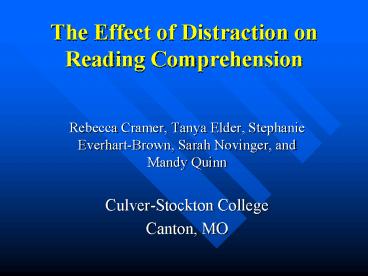The Effect of Distraction on Reading Comprehension - PowerPoint PPT Presentation
1 / 16
Title:
The Effect of Distraction on Reading Comprehension
Description:
This study tested the effect of distraction level on reading comprehension. ... Handicaps. Dyslexia. ADD/ADHD. Agoraphobia. Panic Disorder. Somatoform Disorders ... – PowerPoint PPT presentation
Number of Views:41
Avg rating:3.0/5.0
Title: The Effect of Distraction on Reading Comprehension
1
The Effect of Distraction on Reading
Comprehension
- Rebecca Cramer, Tanya Elder, Stephanie
Everhart-Brown, Sarah Novinger, and Mandy Quinn - Culver-Stockton College
- Canton, MO
2
Abstract
- This study tested the effect of distraction
level on reading comprehension. The participants
consisted of 88 undergraduate students at
Culver-Stockton College. Each participant was
given a passage to read, questions to answer, and
received one of three levels of
distraction high, low, or none. The results
showed an effect of time (time to read the
passage and answer questions), which was
monotonic with the level of distraction, but no
effect of distraction level was found on the
number of errors people made on the questions.
Results are discussed regarding the accurate
assessment of the effect of distractions on
learning in the classroom.
3
DISTRACTION
- Definition Any unusual occurrence that diverts
the attention or concentration of a person. - Levels of Distraction used in the experiment
- High Any loud distraction that exceeds the
normal diversion level. Examples include knocking
over a chair, laughing and eating loudly, etc. - Low Any distraction that barely exceeds the
normal environmental stimuli. Examples include
tapping a pencil and smacking gum, etc. - None Any environmental stimuli that occurs in
the normal classroom setting.
4
COMPARISON
- Previous Study
- (Super, Braasch, Shay 1947)
- No effect of distractions on reading
comprehension (Error measure) - Two levels of distraction
- Vocational test, Mental ability test
- Present Study
- Tested effect of distraction on reading
comprehension (error measure) - Three levels of distraction
- Measured time it took to complete the test.
5
PROBLEM
- Time to complete the test was not a factor in the
previous study. - Level of distraction was not operationally
defined across levels. - Used a standardized test.
6
HYPOTHESIS
- As distraction levels increase, reading
comprehension, as indicated by an increase in
errors, will be compromised. - Additionally, the time that it takes for the
participant to complete the test will increase
monotonically with distraction level.
7
PROCEDURE
- High, Low, Control Group
- Controlled confounds
- Followed script
- Measured Time and Errors.
- Rewarded participants
- Eighty-eight students were tested on
- (A) Reading Comprehension (as measured by number
of errors). - (B) Time to complete the task.
8
RESULTS ERROR MEANS
9
Figure 1 MEAN ERROR RATE
10
RESULTS MEAN TIME TO COMPLETE TASK
11
PLANNED COMPARISONS (TUKEY HSD) ON MAIN EFFECT OF
DISTRACTION ON TIME
12
Figure 2 TIME (Seconds)
13
CONFOUNDS
- Participants created distraction
- Distribution of gender
- Concentration level
- Temperature and time of day
- Intimidation
- Common Knowledge of test questions
14
OTHER CONSIDERATIONS
- Experimenter and participant gender should be
equally distributed across test sessions. - Examples
- Male to Male
- Male to Female
- Female to Female
- Female to Male
15
CONCLUSION
- Main effect of time. It took longer for
participants to complete the test with higher
distraction levels. - No main effect of distraction on reading
comprehension as shown in the error data. - No main effect of gender.
- No other interactions.
16
Further ResearchTest the effect of different
levels of distraction across various age groups
and on people with various handicaps and measure
its effect on reading comprehension and time to
complete the task.
- Age groups
- Elementary
- Junior High School
- High School
- Undergraduate Level
- Graduate Level
- Handicaps
- Dyslexia
- ADD/ADHD
- Agoraphobia
- Panic Disorder
- Somatoform Disorders































